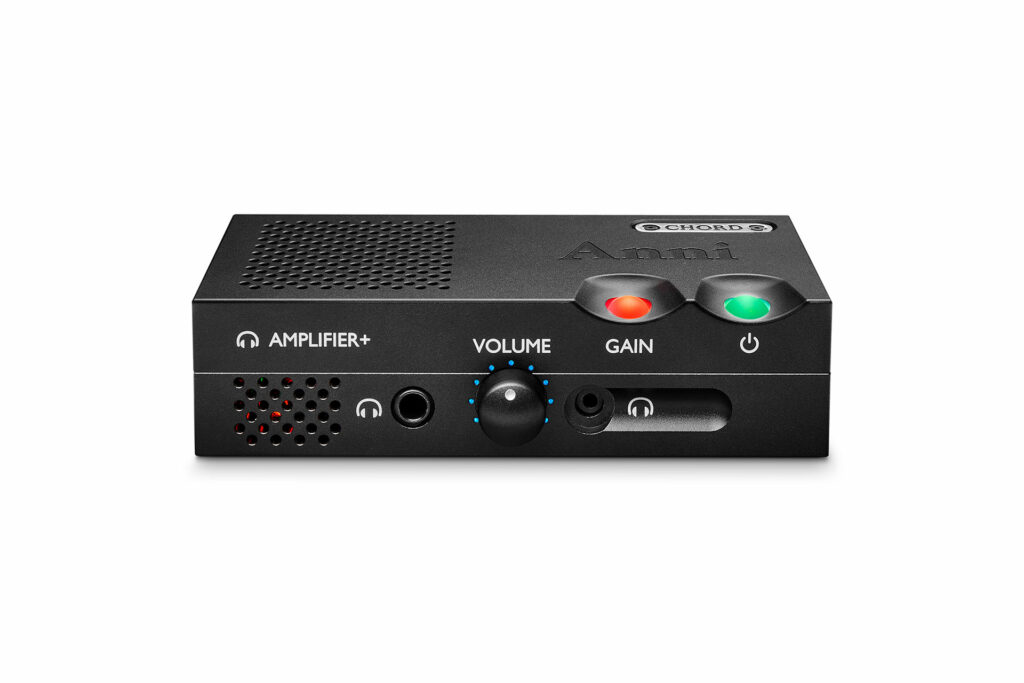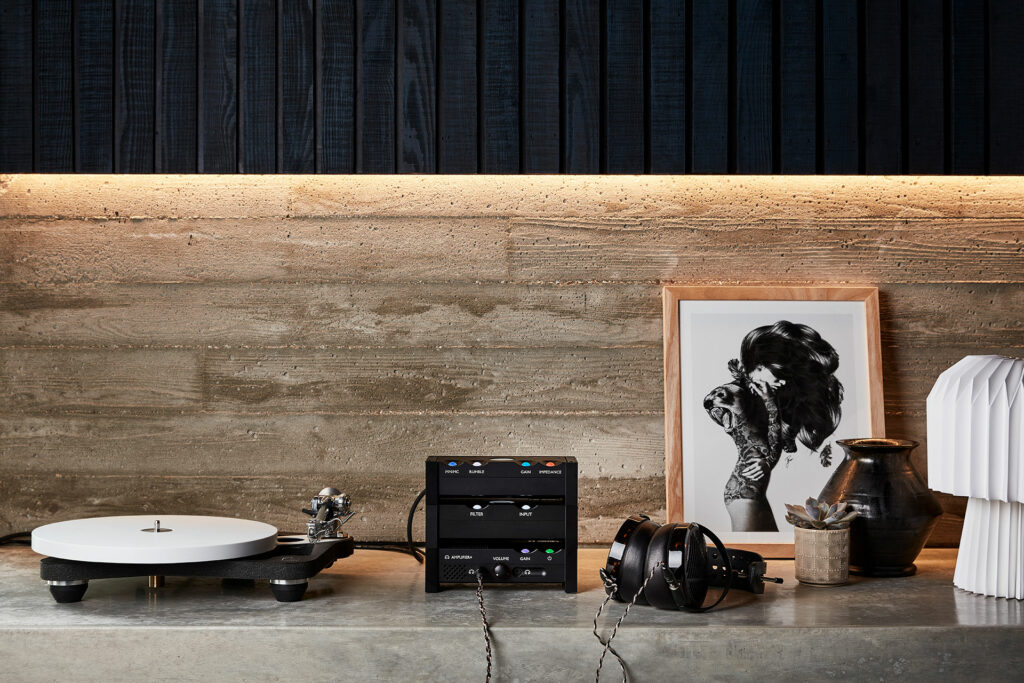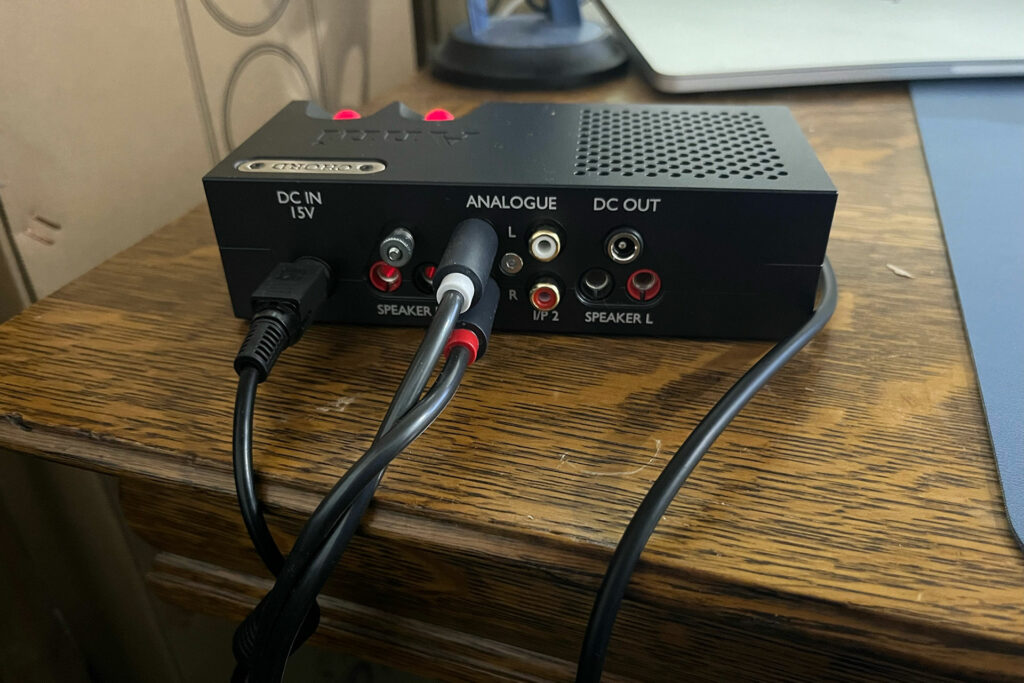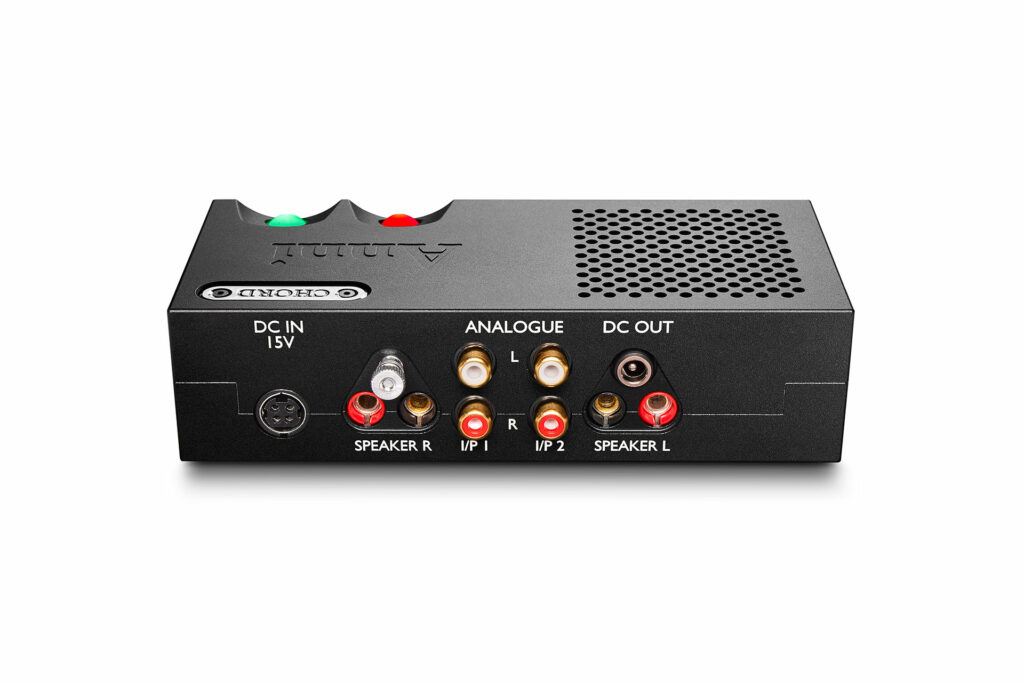The Anni from Chord Electronics is a small form factor, desktop-style integrated amplifier. This small but powerful integrated amplifier features both a 3.5 and a quarter-inch headphone jack, as well as 10 watts into eight ohms of Class AB amplification for speakers. It is otherwise an extremely straightforward integrated amplifier with two RCA inputs on the back, as well as a ground if you’re connecting a turntable. The headphone jacks are on the front, as well as the volume knob, buttons to change the gain if you’re going from headphones to speakers, and a button to turn the device on and off. The simplicity of the unit is a major plus, but the build quality cannot be overstated here, as this little component is built fantastically well, as you should expect from its price tag.

What Makes the Chord Anni Integrated Amplifier Special?
- In a world where small devices often feel cheap, the Chord Anni feels anything but. The housing of this integrated amp is made from solid metal, and for a device that is only 6.2 inches wide, 1.7 inches high, and 3.8 inches deep, weighing in at just 1.4 pounds, it feels like you could easily throw it through a window, then pick it up again, and it wouldn’t have a dent on it. With no extended hyperbole here, this is one of the best-built audio components that our publisher, Jerry Del Colliano (who reviewed the matching DAC), has ever experienced.
- The small form factor of the Chord Anni lets it fit anywhere on your desk (or elsewhere). One of the main complaints I had when I reviewed the FIIO R7 (read my review) was that, because of its size and shape, there wasn’t a good spot for it on my desk. The Chord Anni is the perfect size for me to fit it under one of my computer monitors, or off to the side, without it becoming a focal point or obstructing my view.
- 10 watts of Class AB power is actually plenty of power for nearfield listening. Yes, you likely won’t want to bring this amp out to your living room to drive big, power-hungry floorstanding speakers, but in the context of sitting at your desk, 10 watts is going to be enough, as you’re not going to need to push the volume too hard when you’re sitting within a few feet of your speakers.
Why Should You Care About the Chord Anni Integrated Amplifier?
If you’re a lover of British HiFi, and you’re looking for a well-built headphone amp or amplifier for your desk, then I think you need to look at this component. Chord has a history of more than 30 years of providing audiophile electronics, both in the home and for studios. They have an excellent matching DAC, which only adds to the value proposition. I feel like I am overstating the build quality issue, but let me say it this way… this is no Chi-Fi. Not that I don’t get or like what’s going on in the Chi-Fi world, but this is some Aston Martin-level engineering in a small box designed to make a big sound without taking up a lot of space. That’s why you care about it.

Some Things You Might Not Like About the Chord Anni Integrated Amplifier
- With just 10 watts of power, you will want to make sure you are selective about the speakers you are choosing to pair with it, especially if you are not doing a nearfield speaker setup. Anyone using this on their desk won’t have much issue, but we do have to keep in mind that this integrated amplifier wasn’t designed to fill a medium-sized space, let alone a large one.
- While having the Chord Anni integrated amplifier on my desk, I noticed an audible hum. The folks at Chord informed me that this was likely due to having other electronics around other power sources or components. After I moved some things around, the hum did go away, but if you have a busy desk like I do (a laptop and desktop computer, two monitors, microphone, etc.), you will want to make sure you can find a spot that is further from power sources, so that you won’t have this issue.
- There aren’t any digital inputs. The Chord Anni only has two analog inputs, so what you can use this integrated amp with is somewhat limited. While this isn’t that big of a deal when you keep in mind that it is going to sit on your desktop, you will want to find a small DAC or something that will also fit into your space to feed the sound into the integrated amplifier.
- The integrated amplifier can get a little warm. This isn’t a huge surprise with the size of the Chord Anni’s case, but it is worth noting that it can get a little toasty to the touch. This didn’t affect my ability to modify the volume knob, nor did it ever seem to affect the music in any way.

Listening to the Chord Anni Integrated Amplifier…
I performed my testing with the Chord Anni using a set of HIFIMAN HE-R9 wired headphones, an iFi Zen One Signature DAC (review pending), a MusicHall cd25.3 CD player and my trusty Paradigm Premier 700F speakers.
“Virginia Moon” by the Foo Fighters from their double album In Your Honor is an acoustic track, which features a duet with Dave Grohl and audiophile darling Norah Jones. I listened to this track on Compact Disc, and the Chord Anni thankfully didn’t add any noticeable sonic color or flavor to this track. When listening, there was plenty of separation between the instruments, and you could easily separate the two vocal tracks throughout the harmonies that were being sung by the unlikely due of Grohl and Jones. You wouldn’t expect a Bossa Nova jam from the Foo Fighters, but it really works on this track.
Another track I used was “A Mark Has Been Made” by Nine Inch Nails This instrumental track feels like the start of Trent Reznor’s environment building sounds that ultimately led to him being one of today’s most sought-after movie composers. This track is remarkable for how it builds tension for the listener from early in the track, where it has a very eerie sound, as there is lots of space between the different instruments, before everything starts to come together, and the tension continues to build around the two-minute mark. Throughout all of this, the Chord Anni’s ability to allow the music to have its own space helps build that tension and allows you to build your own images, as that tension builds and ultimately releases as the track moves forward.
Another track I used was “The Punk and the Godfather” by The Who. This is from their Quadrophenia album. I used this track to understand the soundstage, as this is a much more straightforward track. The Chord Anni did a solid job of creating the soundstage, both in headphones and using my Paradigm speakers in a near-field position. The soundstage made it easy to get a sense that the band was positioned in front of you, playing. All of the instruments were clear and had their proper separation and, at loud volumes, there was audible clipping or distortion that was identifiable thought my headphones or my speakers.
Does the Chord Anni Integrated Amplifier Have Any Resale Value?
I would expect the Chord Anni to retain a healthy amount of its value in the resale market for some time to come. Chord Electronics has a great reputation in the audiophile community, and this is certainly a well-built device that I expect will still be in great shape many years after your first buy it. There wasn’t a lot of data on sales, but the one I was able to find was sold for $1,200, which is about two-thirds of the retail price, which is fantastic for a used component.

What Is the Competition For the Chord Anni Integrated Amplifier?
If you’re looking for just a headphone amplifier, the iFi xDSD Gryphon ($599 – buy at Crutchfield) does a lot of the things that the Chord Anni does at one-third the price. You cannot power speakers with this device, but it does have digital inputs and a built-in DAC with USB and mini-S/PDIF support, as well as Bluetooth support. This is also a fraction of the size as well. I enjoyed my time with this headphone amplifier/DAC and, with 3.5mm and 4.4mm headphone support, it has you covered for most headphones.
If you’re looking at just price and features, the NAD C 3050 ($1,399) is a strong contender. This isn’t an apples-to-apples comparison, as the NAD C 3050 isn’t likely to fit onto your desktop, but its base model is less money; even when you add the BluOS module to it, you are within $50 of the Chord Anni. This device was our product of the year last year, and if you’re looking for something that fits more into your traditional integrated amplifier space, you would be well-served to give it a look.
If you are looking for something similar to the Chord Anni, the TEAC AI-301DA-X ($600) should be worth a look. It can deliver up to 60 watts of Class D power, using the ICE Power module. The headphone amplifier has 200 megawatts of power, Bluetooth with aptX support, a 32-bit DAC, DSD support, and even a dedicated subwoofer out. It is about twice the size of the Chord Anni (8.5 × 2.4 ×10 inches for the TEAC vs 6.2-wide, 1.7- high, and 3.8 for the Chord), but you’re getting a lot of features and a device that will fit onto most desktops.

Final Thoughts on the Chord Anni Integrated Amplifier…
The Chord Anni is a fantastic desktop integrated amplifier; the things it does, it does really well. Both the headphone amplifier and the outbound amplifier play music that doesn’t feel as if it has been colored. The issue I take with this product is ultimately its value proposition. At nearly $2,000, in an audiophile world where it seems like we have reached a point where we can compress the size of quality components enough to fit them all into a neat and tidy package, Chord ultimately chose to play it safe and stick to what it does best, and place it inside of a well-built box, instead of trying to fit a DAC, a streamer and other things into the package. You will without doubt find desktop integrated amplifiers that do more, but the Chord Anni does sonics well enough that you can love it now and add the other components you want to listen through it later.




As usual Chord components are over priced.
As usual Chord is over priced.
That’s an interesting outlook…
I just got back from the Munich show and I don’t think I saw one component priced as low as the Chord Gear (they were there but not as much the US importer who is our client – The Sound Org)….
Chord gear is AMAZINGLY well built, nicely engineered and sounds solid from a small physical package.
With $4,000,000 audio systems on display at AXPONA and Munich and countless $20,000 to $100,000 components being shown everywhere – this seems like a very aspirational and seemingly affordable component.
If it makes you feel any better, I booked a review of the new Outlaw Audio $999 integrated amp just yesterday. We are here for EVERY AUDIOPHILE… 🙂